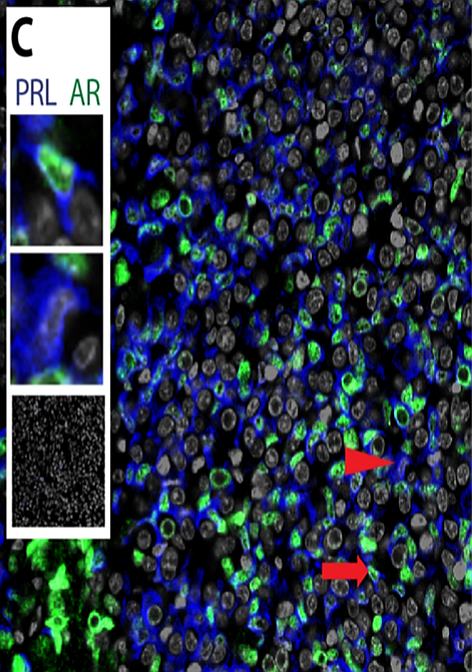|
Witch's Milk
Witch's milk or neonatal milk is milk secreted from the breasts of some newborn human infants of either sex. Production of neonatal milk by infants usually resolves itself and does not require treatment unless it is caused by an underlying condition or medications. It is thought to be caused by the exposure to an elevated level of estrogen to infants during pregnancy or decreased exposure of estrogen to infants after birth. Its production also may be caused by certain medications. The composition of neonatal milk is similar to maternal milk for most of their components except for fats and one type of antibody. Neonatal milk production occurs in about 6% of newborns with age from 0 to 12 weeks. Within the age range, infants age 0 to 2 weeks were found to have the highest occurrence. Compared to those who did not have neonatal milk production, infants who did had larger breast nodules. Pre-term infants under the gestational age of 34 weeks did not secrete milk as observed in one s ... [...More Info...] [...Related Items...] OR: [Wikipedia] [Google] [Baidu] |
Milk
Milk is a white liquid food produced by the mammary glands of lactating mammals. It is the primary source of nutrition for young mammals (including breastfeeding, breastfed human infants) before they are able to digestion, digest solid food. Milk contains many nutrients, including calcium and protein, as well as lactose and saturated fat; the enzyme lactase is needed to break down lactose. Immune factors and immune-modulating components in milk contribute to milk immunity. The first milk, which is called colostrum, contains antibody, antibodies and immune-modulating components that milk immunity, strengthen the immune system against many diseases. As an agricultural product, Milking, milk is collected from farm animals, mostly cattle, on a dairy. It is used by humans as a drink and as the base ingredient for dairy products. The US Centers for Disease Control and Prevention, CDC recommends that children over the age of 12 months (the minimum age to stop giving breast milk or Ba ... [...More Info...] [...Related Items...] OR: [Wikipedia] [Google] [Baidu] |
Lactotrophs
A prolactin cell (also known as a lactotropic cell, epsilon acidophil, lactotrope, lactotroph, mammatroph, mammotroph) is a cell (biology), cell in the anterior pituitary which produces prolactin (a peptide hormone) in response to hormonal signals including dopamine (which is inhibitory), thyrotropin-releasing hormone and estrogen (especially during pregnancy), which are stimulatory. Prolactin is responsible for actions needed for body homeostasis, the development of breasts, and for lactation. The inhibitory effects of dopamine override the stimulatory effects of TRH in non-pregnant, non-lactating sexually mature females. Depending on the sex of the individual, prolactin cells account for 20% - 50% of all cells in the anterior pituitary gland. Other regulators include oxytocin and progesterone. Males and non-pregnant, non-lactating females typically have low levels of prolactin. The number for prolactin cells in a pregnant female will increase to allow for breast tissue developm ... [...More Info...] [...Related Items...] OR: [Wikipedia] [Google] [Baidu] |
Streptococcus
''Streptococcus'' is a genus of gram-positive spherical bacteria that belongs to the family Streptococcaceae, within the order Lactobacillales (lactic acid bacteria), in the phylum Bacillota. Cell division in streptococci occurs along a single axis, thus when growing they tend to form pairs or chains, which may appear bent or twisted. This differs from staphylococci, which divide along multiple axes, thereby generating irregular, grape-like clusters of cells. Most streptococci are oxidase-negative and catalase-negative, and many are facultative anaerobes (capable of growth both aerobically and anaerobically). The term was coined in 1877 by Viennese surgeon Albert Theodor Billroth (1829–1894), by combining the prefix "strepto-" (from ), together with the suffix "-coccus" (from Modern , from .) In 1984, many bacteria formerly grouped in the genus ''Streptococcus'' were separated out into the genera '' Enterococcus'' and '' Lactococcus''. Currently, over 50 species are ... [...More Info...] [...Related Items...] OR: [Wikipedia] [Google] [Baidu] |
Staphylococcus Aureus
''Staphylococcus aureus'' is a Gram-positive spherically shaped bacterium, a member of the Bacillota, and is a usual member of the microbiota of the body, frequently found in the upper respiratory tract and on the skin. It is often positive for catalase and nitrate reduction and is a facultative anaerobe, meaning that it can grow without oxygen. Although ''S. aureus'' usually acts as a commensal of the human microbiota, it can also become an opportunistic pathogen, being a common cause of skin infections including abscesses, respiratory infections such as sinusitis, and food poisoning. Pathogenic strains often promote infections by producing virulence factors such as potent protein toxins, and the expression of a cell-surface protein that binds and inactivates antibodies. ''S. aureus'' is one of the leading pathogens for deaths associated with antimicrobial resistance and the emergence of antibiotic-resistant strains, such as methicillin-resistant ''S. aur ... [...More Info...] [...Related Items...] OR: [Wikipedia] [Google] [Baidu] |
Hyperthyroidism
Hyperthyroidism is a endocrine disease in which the thyroid gland produces excessive amounts of thyroid hormones. Thyrotoxicosis is a condition that occurs due to elevated levels of thyroid hormones of any cause and therefore includes hyperthyroidism. Some, however, use the terms interchangeably. Signs and symptoms vary between people and may include irritability, muscle weakness, sleeping problems, a tachycardia, fast heartbeat, heat intolerance, diarrhea, goitre, enlargement of the thyroid, hand tremor, and weight loss. Symptoms are typically less severe in the elderly and during pregnancy. An uncommon but life-threatening complication is thyroid storm in which an event such as an infection results in worsening symptoms such as confusion and a hyperthermia, high temperature; this often results in death. The opposite is hypothyroidism, when the thyroid gland does not make enough thyroid hormone. Graves' disease is the cause of about 50% to 80% of the cases of hyperthyroidism ... [...More Info...] [...Related Items...] OR: [Wikipedia] [Google] [Baidu] |
Hyperprolactinaemia
Hyperprolactinaemia (also spelled hyperprolactinemia) is a condition characterized by abnormally high levels of prolactin in the blood. In women, normal prolactin levels average to about 13 ng/mL, while in men, they average 5 ng/mL. The upper normal limit of serum prolactin is typically between 15 and 25 ng/mL for both genders. Levels exceeding this range indicate hyperprolactinemia. Prolactin (PRL) is a peptide hormone produced by lactotroph cells in the anterior pituitary gland. It plays a vital role in lactation and breast development. Hyperprolactinemia, characterized by abnormally high levels of prolactin, may cause galactorrhea (production and spontaneous flow of breast milk), infertility, and menstrual disruptions in women. In men, it can lead to hypogonadism, infertility and erectile dysfunction. Prolactin is crucial for milk production during pregnancy and lactation. Together with estrogen, progesterone, insulin-like growth factor-1 (IGF-1), and horm ... [...More Info...] [...Related Items...] OR: [Wikipedia] [Google] [Baidu] |
Prolactinoma
A prolactinoma is a tumor (adenoma) of the pituitary gland that produces the hormone prolactin. It is the most common type of functioning pituitary tumor. Symptoms of prolactinoma are due to abnormally high levels of prolactin in the blood ( hyperprolactinemia), or due to pressure of the tumor on surrounding brain tissue and/or the optic nerves. Based on its size, a prolactinoma may be classified as a microprolactinoma (10mm diameter). Signs and symptoms The most common symptoms at the time of diagnosis often differ between males and females. Women tend to experience more symptoms related directly to prolactin levels, such as an absense of menstruation and lactation outside of nursing or recent childbirth. By contrast, men frequently exhibit fertility issues and hormonal disruptions, such as a loss of libido, but are also more likely to show signs of the tumor compressing their brain tissue, such as headaches, vision changes, and other symptoms outlined below. The symptoms du ... [...More Info...] [...Related Items...] OR: [Wikipedia] [Google] [Baidu] |
Opiates
An opiate is an alkaloid substance derived from opium (or poppy straw). It differs from the similar term ''opioid'' in that the latter is used to designate all substances, both natural and synthetic, that bind to opioid receptors in the brain (including antagonists). Opiates are alkaloid compounds naturally found in the opium poppy plant ''Papaver somniferum''. The psychoactive compounds found in the opium plant include morphine, codeine, and thebaine. Opiates have long been used for a variety of medical conditions, with evidence of opiate trade and use for pain relief as early as the eighth century AD. Most opiates are considered drugs with moderate to high abuse potential and are listed on various "Substance-Control Schedules" under the Uniform Controlled Substances Act of the United States of America. In 2014, between 13 and 20 million people used opioids recreationally, representing 0.3% to 0.4% of the global population between the ages of 15 and 65. According to the CDC, ... [...More Info...] [...Related Items...] OR: [Wikipedia] [Google] [Baidu] |
Dopamine
Dopamine (DA, a contraction of 3,4-dihydroxyphenethylamine) is a neuromodulatory molecule that plays several important roles in cells. It is an organic chemical of the catecholamine and phenethylamine families. It is an amine synthesized by removing a carboxyl group from a molecule of its precursor chemical, L-DOPA, which is synthesized in the brain and kidneys. Dopamine is also synthesized in plants and most animals. In the brain, dopamine functions as a neurotransmitter—a chemical released by neurons (nerve cells) to send signals to other nerve cells. The brain includes several distinct dopamine pathways, one of which plays a major role in the motivational component of reward-motivated behavior. The anticipation of most types of rewards increases the level of dopamine in the brain, and many addictive drugs increase dopamine release or block its reuptake into neurons following release. Other brain dopamine pathways are involved in motor control and in controllin ... [...More Info...] [...Related Items...] OR: [Wikipedia] [Google] [Baidu] |
Breastfeeding
Breastfeeding, also known as nursing, is the process where breast milk is fed to a child. Infants may suck the milk directly from the breast, or milk may be extracted with a Breast pump, pump and then fed to the infant. The World Health Organization (WHO) recommend that breastfeeding begin within the first hour of a baby's birth and continue as the baby wants. Health organizations, including the WHO, recommend breastfeeding exclusively for six months. This means that no other foods or drinks, other than vitamin D, are typically given. The WHO recommends exclusive breastfeeding for the first 6 months of life, followed by continued breastfeeding with appropriate complementary foods for up to 2 years and beyond. Of the 135 million babies born every year, only 42% are breastfed within the first hour of life, only 38% of mothers practice exclusive breastfeeding during the first six months, and 58% of mothers continue breastfeeding up to the age of two years and beyond. Breastfee ... [...More Info...] [...Related Items...] OR: [Wikipedia] [Google] [Baidu] |
Hyperprolactinemia
Hyperprolactinaemia (also spelled hyperprolactinemia) is a condition characterized by abnormally high levels of prolactin in the blood. In women, normal prolactin levels average to about 13 ng/mL, while in men, they average 5 ng/mL. The upper normal limit of serum prolactin is typically between 15 and 25 ng/mL for both genders. Levels exceeding this range indicate hyperprolactinemia. Prolactin (PRL) is a peptide hormone produced by lactotroph cells in the anterior pituitary gland. It plays a vital role in lactation and breast development. Hyperprolactinemia, characterized by abnormally high levels of prolactin, may cause galactorrhea (production and spontaneous flow of breast milk), infertility, and menstrual disruptions in women. In men, it can lead to hypogonadism, infertility and erectile dysfunction. Prolactin is crucial for milk production during pregnancy and lactation. Together with estrogen, progesterone, insulin-like growth factor-1 (IGF-1), and horm ... [...More Info...] [...Related Items...] OR: [Wikipedia] [Google] [Baidu] |
Galactorrhea
Galactorrhea ( also spelled galactorrhoea) ( galacto- + -rrhea) or lactorrhea ( lacto- + -rrhea) is the spontaneous flow of milk from the breast, unassociated with childbirth or nursing. Galactorrhea is reported to occur in 5–32% of females. Much of the difference in reported incidence can be attributed to different definitions of galactorrhea. Although frequently benign, it may be caused by serious underlying conditions and should be properly investigated. Galactorrhea also occurs in males, newborn infants and adolescents of both sexes. Causes Galactorrhea can take place as a result of dysregulation of certain hormones. Hormonal causes most frequently associated with galactorrhea are hyperprolactinemia and thyroid conditions with elevated levels of thyroid-stimulating hormone (TSH) or thyrotropin-releasing hormone (TRH). No obvious cause is found in about 50% of cases. Lactation requires the presence of prolactin, and the evaluation of galactorrhea includes eliciting a h ... [...More Info...] [...Related Items...] OR: [Wikipedia] [Google] [Baidu] |






